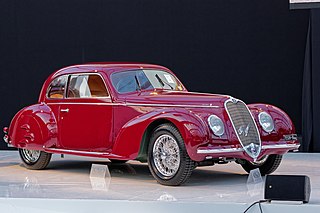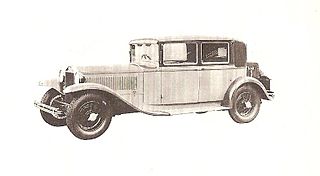
DKW was a German car- and motorcycle-marque. DKW was one of the four companies that formed Auto Union in 1932 and thus became an ancestor of the modern-day Audi company.
The Classic Car Club of America (CCCA) is an organization founded in 1952 with a goal of celebrating the automobiles of the prewar period. At the time, the vehicles covered by the club were considered too modern to be of any interest by such organizations as the Antique Automobile Club of America, and despite their often stupendous cost when new, were considered practically worthless.

The Mille Miglia was an open-road, motorsport endurance race established in 1927 by the young Counts Francesco Mazzotti and Aymo Maggi. It took place in Italy 24 times from 1927 to 1957.

The Lancia Aurelia is a car produced by Italian manufacturer Lancia from 1950 to the summer of 1958. It is noted for using one of the first series-production V6 engines. Several body styles were offered: 4-door saloon, 2-door GT coupé (B20), 2-door spider/convertible (B24), and a chassis to be custom bodied by external coachbuilders.

The Lancia Lambda is an innovative automobile produced from 1922 through 1931. It was the first car to feature a load-bearing unitary body, and it also pioneered the use of an independent suspension. Vincenzo Lancia even invented a shock absorber for the car and it had excellent four wheel brakes. Approximately 11,200 Lambdas were produced.

The Lancia Montecarlo is a Pininfarina-designed mid-engined sports car produced by Lancia in Italy from 1975 to 1981.

The Bugatti Type 51 series succeeded the famous Type 35 as Bugatti's premier racing car for the 1930s. The main distinction is that it uses a twin cam engine. Unlike the dominant Type 35s of the prior decade, the Type 51 were unable to compete with the government-supported German and Italian offerings.

The Lancia Appia is a passenger car introduced in 1953 by Italian car manufacturer Lancia as a replacement for the Ardea, and which remained in production for ten years. The Appia was the last in a long line of Lancia production cars dating back to the Lancia Lambda to use sliding pillar front suspension. All three series produced had a 1089cc Lancia V4 engine.

The Alfa Romeo 6C name was used on road, race, and sports cars produced between 1927 and 1954 by Alfa Romeo; the "6C" name refers to the six cylinders of the car's straight-six engine. Bodies for these cars were made by coachbuilders such as James Young, Zagato, Touring Superleggera, Castagna, and Pinin Farina. Beginning in 1933 there was also a 6C version with an Alfa factory body, built in Portello. In the early 1920s Vittorio Jano received a commission to create a lightweight, high performance vehicle to replace the Giuseppe Merosi designed RL and RM models. The car was introduced in April 1925 at the Salone dell' Automobile di Milano as the 6C 1500. It was based on Alfa's P2 Grand Prix car, using a single overhead cam 1,487 cc in-line six-cylinder engine, producing 44 horsepower. In 1928 the 1500 Sport was presented, which was the first Alfa Romeo road car with double overhead camshafts.

The Lancia Aprilia (1937–1949) is a family car manufactured by Lancia, one of the first designed using a wind tunnel in collaboration with Battista Farina and Politecnico di Torino, achieving a record low drag coefficient of 0.47. The berlinetta aerodinamica was first shown in 1936.

A V8 engine is an eight-cylinder piston engine in which two banks of four cylinders share a common crankshaft and are arranged in a V configuration.

The Lancia Artena is a passenger car produced by Italian car manufacturer Lancia from 1931 until 1936, and from 1940 until 1942 chiefly for army and government use. It was powered by a 2-litre Lancia V4 engine, while chassis and factory bodies were shared with the more luxurious 2.6-litre V8-engined Lancia Astura. Total production amounted to 5,567 examples.

The Lancia Augusta is a small passenger car produced by Italian car manufacturer Lancia between 1933 and 1936. It made its première at the 1932 Paris Motor Show. The car was powered by a 1,196 cc Lancia V4 engine.

Carrozzeria Castagna is an Italian coachbuilding company based in Milan, Italy.

Carrozzeria Boneschi S.r.L. is an Italian coachbuilder, mainly of commercial vehicles. Until 1960, the company was mostly involved with automobile manufacturers such as Talbot, Rolls-Royce, Alfa Romeo, Lancia and Fiat. It was established in Milan by Giovanni Boneschi, moving to Cambiago in (1933). The factory was rebuilt after World War II (1946), after which Boneschi died. Among its designers and directors in the later years was Dr. Bruno Pezzaglia. Boneschi brand has recently been acquired by the coachbuilder Savio.

The Lancia Astura is a passenger car produced by Italian automobile manufacturer Lancia between 1931 and 1939. Lancia replaced the Lambda model with two models: the four-cylinder Artena and the larger, V8-powered Astura. Both of these models were introduced at the Paris Motor Show in 1931. The Astura chassis was used by various coachbuilders to create coupes, convertibles and sedans.

Carrosserie Pourtout was a French coachbuilding company. Founded by Marcel Pourtout in 1925, the firm is best known for its work in the decades prior to World War II, when it created distinctive and prestigious bodies for cars from numerous European manufacturers. Pre-war Pourtout bodies were mainly one-off, bespoke creations, typically aerodynamic and sporting in character. Together with chief coach designer and stylist Georges Paulin from 1933 to 1938, Pourtout pioneered the Paulin invented 'Eclipse' retractable hardtop system on four models of Peugeot, several Lancia Belna's and other car makes.
Among the company's customers was Georges Clemenceau, the physician and journalist who served as the prime minister of France from 1906 to 1909 and 1917 to 1920.
Concorso d'Eleganza Villa d'Este is a Concours d'Elegance event in Italy for classic and vintage cars. It takes place annually near the Villa d'Este hotel in Cernobbio, on the western shore of Lake Como in northern Italy. Since 2011, the event has taken place in the second half of May.
The Lancia Ro, Lancia Ro-Ro and Lancia 3Ro were 4x2 heavy trucks built by Italian manufacturer Lancia from the 1930s through the 1940s for military and civilian use. The 2-cylinder diesel Ro was produced from 1933 to 1939, the 3-cylinder diesel Ro-Ro from 1935 to 1939 and the improved 5-cylinder diesel 3Ro from 1938 to 1947.

The Lancia Jota is a series of truck and bus chassis produced by Lancia between 1915 and 1935. The original 1915 Jota was the first true Lancia truck; throughout the following two decades it was made in a number of different series and variants, each identified by a progressive Greek numeral prefix added to the name, from Djota to the last Eptajota. While axle tracks, wheelbase and equipment gradually grew, the original layout and 4,940 cc four-cylinder petrol engine were retained.




















